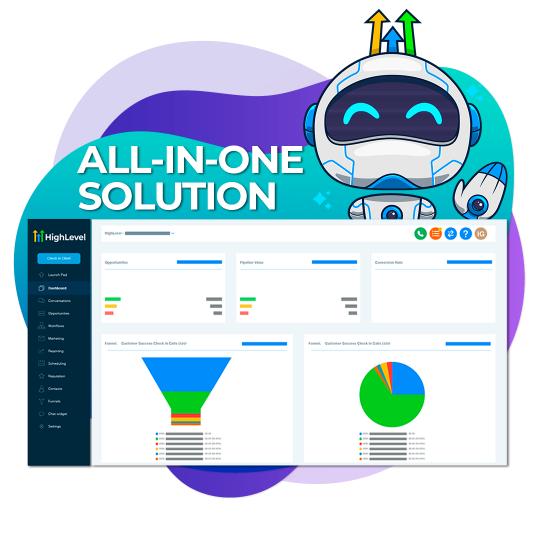CRM tools can feel more friendly when you mix tech with real human care. Most people like talking to real humans. But smart tech helps your team spend more time with customers. They don't have to do boring tasks. Instead, they can focus on what matters – helping people.
AI can see how your customers feel. It learns what they like to do. This helps you send them better messages. You can write to each person in a way that fits them. The tech also tells you when to reach out.
Remember: Use tech to build better bonds with people. Don't let it take over real human talks.
Feeling overwhelmed by missed leads and disorganized workflows?
Discover the award-winning platform that automates follow-ups, tracks every lead, and keeps your business running smoothly—all in one place. Thousands of businesses are already transforming their sales and marketing with this trusted solution. Don’t miss out—start your 14-day free trial today and click now to uncover exclusive, limited-time special offers!
The Human Touch Paradox

Helping people while using computers is tricky. Many of us want to talk to real people, not robots. In fact, 7 out of 10 shoppers like talking to humans better than machines.
People are happy to spend more money when they get real human care. It feels special, like someone is truly looking after them. But many companies use too many computers and forget about the human touch. More than half of their customers feel left out.
The best way to fix this is to use both computers and people. Let computers do the boring work. Keep real people for the important talks with customers. This way, you can save time but still make customers feel cared for.
You should let computers handle:
- Simple questions
- Basic tasks
- Sending emails
- Making lists
Save your people for:
- Hard problems
- Big decisions
- Special care
- Making friends with customers
Understanding Customer Emotions Through AI
AI helps us see how customers feel when they talk to us online. Just like we can tell if a friend is happy or sad by their face, AI tools can tell how customers feel by how they use websites and apps.
When customers type fast or move their mouse in certain ways, it tells us something about their mood. This helps us be kinder and more helpful.
We can give better service because we know what our customers need. It's like having a friend who really listens and cares about how you feel.
Decoding Digital Body Language
When we talk online, it's hard to know how people feel. But now we can use smart tools to better understand our customers.
Most of our chats happen on screens now. Many times, we get the wrong idea from emails. That's why we need good tools to help us know what customers want.
Here's what you can do to understand customers better:
- Watch faces during video calls to see if people are happy or sad
- Look at the words people write to know how they feel
- Learn from past chats to guess what customers might do next
These simple steps help you connect with customers, even when you can't meet them in person.
AI-Powered Sentiment Recognition
Computers can now understand how people feel when they write or talk online. These smart tools read messages, emails, and social media posts to tell if someone is happy, sad, or angry.
Teams can use this to help customers faster. If someone writes an angry email, the computer spots it right away. This means helpers can fix big problems first.
These tools also show which people might want to buy something. They track if folks are saying good or bad things about a company. This lets teams spend more time talking to the people who need help most.
When teams use these smart tools, they can give better service to more people. The computer does the boring work, so people can focus on helping customers feel better.
Empathy Through Machine Learning
AI helps us care more about how customers feel. We use three tools that work together:
- Cameras that see faces and what they mean
- Tools that listen to how people talk
- Systems that read words to know if people are happy or sad
When we know how people feel, we can help them better:
- We can fix problems right away when someone is upset
- We can help before people ask by watching their face and hearing their voice
- We can give each person the help they need by looking at their messages
These tools let us be kind and helpful. We can make people happy before they get mad.
This makes customers feel good and helps our team do better work.
Ready to simplify your business operations?
Streamline your workflows and boost productivity with a CRM designed to save you time and effort. From tracking leads to automating follow-ups, this platform does it all. Discover what’s possible—learn more about how it works and see why so many businesses rely on it every day.
Building Trust With Automated Systems

Trust is key when computers help serve customers. These systems need to show they care about you and work well every time.
When a computer knows your name and past chats, it feels more like talking to a friend. Good systems keep your info safe with extra login steps. They also let you know how they protect your data.
Some tasks are best for computers, like sending quick updates. But when big problems come up, real people should step in to help. The computer keeps track of all your chats so it can give better help next time.
The system checks in with you to make sure you're happy. When you need fast help, chat robots are there right away.
These systems follow strict rules to keep your info safe, and they tell you about it in clear words.
Still struggling to keep your business organized?
Take the guesswork out of managing leads and follow-ups with a platform trusted by thousands of businesses. Say goodbye to missed opportunities and hello to a seamless sales process. Act now—try it free for 14 days and discover how easy it is to stay on top of your workflow. Don’t wait—exclusive offers won’t last long!
Smart Personalization at Scale
We help make your business more personal with smart tools.
These tools learn what your customers like and help you talk to them better.
Think of it like having a helper who knows what each customer wants. When someone visits your website or opens your email, they get messages just for them.
To make this work well:
- Use simple tools that send the right message to the right person
- Make your tools spot when customers do something, then act fast
- Look at what works best and fix what doesn't
That's how you can talk to lots of people but make each one feel special.
Beyond Generic Customer Service

We want to make each customer feel special. We can learn what they like by looking at their past chats and orders. This helps us talk to them in a way that fits them best.
When we send emails or talk on the phone, we can use what we know to make them feel heard. Our smart tools help us keep track of what each person wants.
But we also make sure real people are there to help when needed. This makes customers happy and they stay with us longer.
Tailoring Engagement Through Data
Data helps us talk better to customers. Now we can learn what each person likes and needs.
We use special tools to remember things about our customers. This lets us send them messages they care about.
These tools help us:
- Look at what customers buy and like
- Send nice emails when customers do things
- Keep track of special info about each person
Watch how well your messages work. See what makes customers happy. Then do more of what works best.
The tools do the hard work. This gives you time to make each customer feel special. And you can do this for lots of people at once.
Keep checking your results. Change what you do based on what works. This helps you get better at making customers happy.
Building Authentic Connections
Making real friends takes care and work. We need to feel what others feel. We need to share stories from our lives. We need to be honest. And we need to be there in person sometimes.
When you talk to people, listen to how they feel. Share your own true stories so they know you care. Tell them the truth about who you're and what you can do.
Some tasks can be done by computers. But save time to write notes by hand or meet face to face. These small acts make people feel special.
Watch how others act and what they like. Then talk to them about things they care about. But most of all, listen well and show you care when they need you.
Struggling to keep up with your growing business?
Simplify your processes and stay ahead with a CRM that adapts to your needs. Manage leads, automate tasks, and focus on what matters most—growing your business. Take the first step—explore the features today and see how it can transform the way you work.
Real-Time Response Done Right
We want to help customers faster with smart tools that work right away.
Think of it like having a helper that never sleeps and always knows what to do next.
Our tools talk to each other so no one has to type the same thing twice.
This keeps all the info clean and right.
Three big things make this work better:
- Smart rules that pick what to do first
- Big screens that show us what customers need right now
- A mix of robots and people to fix problems
When a robot can't help, a real person steps in.
This way, everyone gets the help they need fast.
Empathy Through Data Analysis

We can use data to better help and care for our customers. When we look at the numbers behind each customer, we see their real story. This helps us treat them like people, not just numbers.
Our teams can track how customers act and what they need. This lets us help them in a way that shows we care. We mix smart computer systems with kind human touch. This way, we keep things running well while still being friendly.
We give our workers the tools they need to see all customer info in one place. This helps them be caring and helpful every time they talk to customers.
Creating Authentic Digital Relationships
Making Real Friends Online
It's important to mix smart tools with real human care when connecting online. Be open about how you use technology. Show people you care about them as real humans, not just numbers.
Here's what works best to make true online friends:
- Use tools that help you talk to each person like you know them.
- Stay the same friendly self everywhere online.
- Make places where people can talk and share good things with each other.
Keep in touch often. Listen to what people say they need. Use what you learn to be a better friend. Make sure you protect their private info too.
The key is to be real. Talk like a person, not a robot. Share helpful things. Care about others. When you do this right, you build trust that lasts.
Remember: Good online friends are just like real-life friends. They need care, time, and honest talk to grow strong.
When Machines Learn Human Behavior

Machines watch and learn how we act, just like a friend who gets to know us better over time. They keep track of what we buy, which websites we visit, and how we talk to companies.
Think of it like this:
When you shop, machines remember what you like to buy.
When you browse websites, they see what catches your eye.
When you need help, they learn how to fix common problems.
When you read emails, they notice which ones you open.
These smart machines use simple clues to guess what you might want next. They can tell if you're happy or unhappy with a company. They know when to reach out with helpful tips or special deals.
It's like having a helper who:
- Knows what you might want to buy
- Shows you things you care about
- Fixes problems before they get big
- Talks to you in a way you like
The more these machines work with us, the better they get at helping us get what we need, right when we need it.
Emotional Intelligence Meets Automation
We help people feel heard and cared for when they talk to us. Our smart tools learn what makes each person happy or sad. We respond in kind ways that show we care.
When we do this, more people feel good about working with us. Our tools look at how people act and what they say. This helps us send messages that feel real and friendly.
We want every chat to feel like talking to a good friend who listens well.
Building Trust Through AI
AI helps us connect better with customers by understanding how they feel. Just like a good friend who listens, smart computers can help us know when someone is happy or upset.
We want to mix the best of both worlds – friendly humans and helpful computers. This way, customers know we care about them.
Three ways we do this:
- We use tools that can tell how customers feel when they talk to us.
- We let humans step in when needed, so customers always get real care.
- We learn what makes each customer special and remember it for next time.
These simple steps help us build trust with customers, just like you'd with a new friend.
Empathy-Driven Digital Engagement
Caring about how customers feel is key to building good relationships online. When we mix machines with human care, we can better help people while working smart. Being kind to customers makes them happy. Happy customers spend more money with us.
Here's how we show we care online:
- We use smart tools to understand how people feel
- We let humans help when needed
- We look at all customer info to serve them better
Let computers handle simple tasks. Have real people step in for hard problems. Use online tools that help your team spot feelings and respond with care. This way, you keep things personal while getting more done.
[Table in simple terms]
What We Do | How We Do It Online
—|—
Read Feelings | Use smart tools to spot emotions
Stay Personal | Mix computer help with human help
Use Info Well | Put customer facts together to help better
Understanding Behavioral Patterns
Smart systems help us understand how customers feel and act. They watch what customers do and help make things better. When we know what makes customers happy, we can help them more.
We can make this work by:
- Looking at how customers feel when they talk to us
- Sending the right messages to customers at the right time
- Watching how customers act and giving them rewards they like
The more we learn about our customers, the better we can make them smile.
And happy customers come back more often.
Balancing Technology With Personal Connection

We need to mix computers with real people when helping customers. Many companies know that being friendly and human helps them do better. This means using tools that help people talk to each other, not replace them.
Use computer systems to learn about customers, but have real people handle big problems. Let computers do the small, easy jobs. This gives your team more time to really talk with customers.
Many times, talking on screens isn't as good as talking face to face. So make sure you know when to stop using computers and let people help instead. Ask customers what they think so you can make your system better while keeping kind and real connections.
Conclusion
We can use smart tools to help us care more about each customer. Think of it like having a helper who remembers what people like and need. These tools give us more time to talk and listen to customers in a real way. When we mix smart tech with being kind and caring, we build trust that lasts. It's like having a friend who knows just what you want, but better because we can help more people at once.








